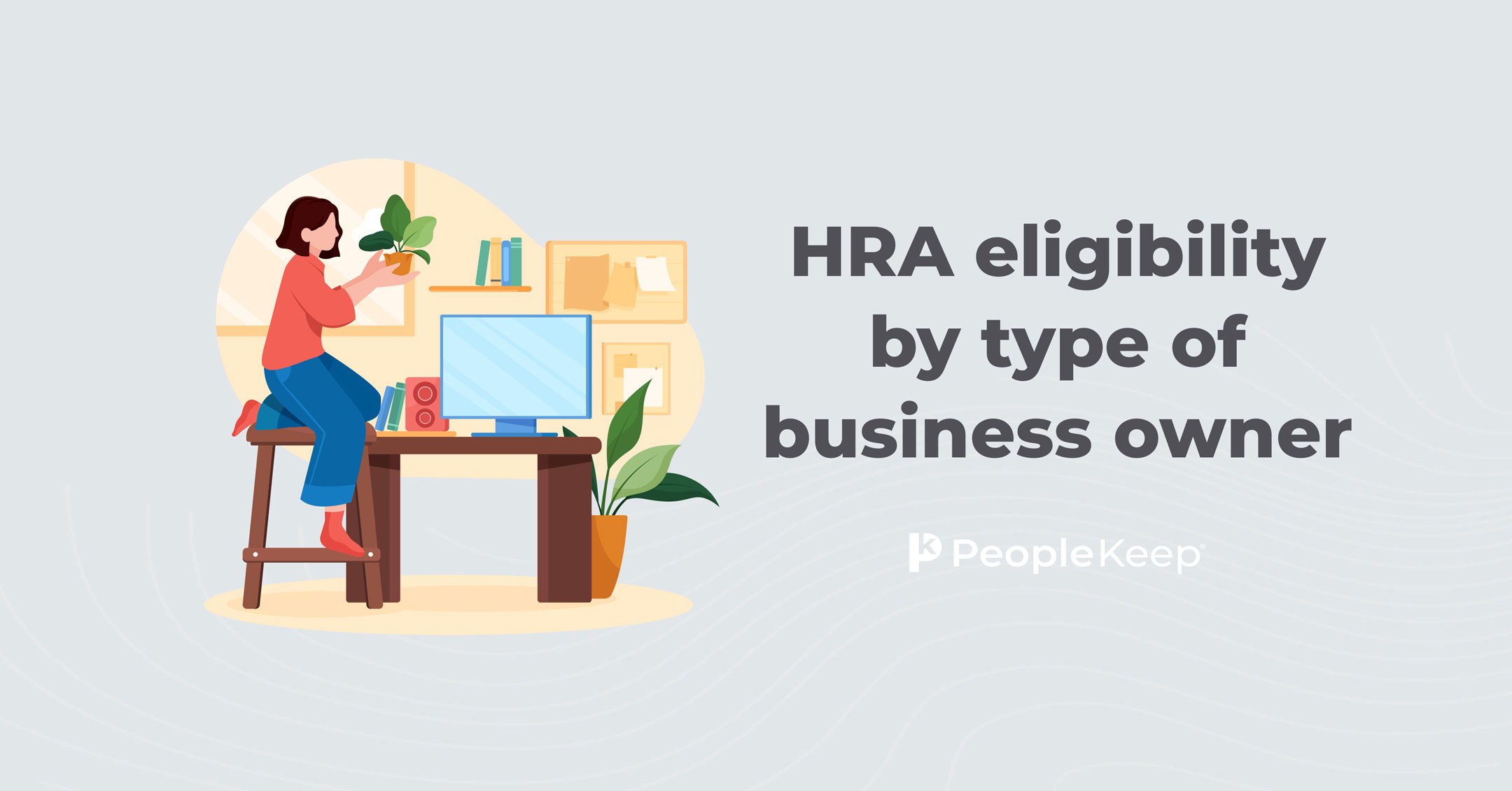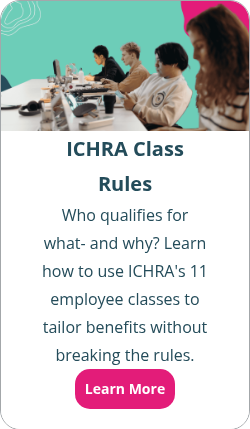Individual coverage HRA (ICHRA) employee classes
By Chase Charaba on August 1, 2024 at 8:05 AM
One of the most exciting things that sets the individual coverage health reimbursement arrangement (ICHRA) apart from other HRAs is the flexibility to designate different employee classes.
With the ICHRA, employers can leverage up to 11 different employee classes to categorize employees into groups and make it easier to customize benefits. When used well, these classes help businesses more effectively use their health benefit to attract and retain valuable employees.
Below, we'll go over the 11 employee classes and how you can use them to define ICHRA benefit eligibility and allowance amounts so they match your health benefit goals.
Takeaways from this blog post:
- An ICHRA allows organizations to reimburse employees for their individual health insurance premiums and other out-of-pocket costs on a pre-tax basis.
- Employee classes for an ICHRA include full-time, part-time, seasonal, salaried, hourly, and more, allowing for customization based on job-based criteria.
- Employers can also vary allowance amounts based on employee age, family status, and geographic location to better recruit and retain desired employees.
What is an ICHRA, and how does it work?
An ICHRA is an employee health benefit that allows organizations to reimburse employees on a pre-tax basis for more than 200 types of out-of-pocket medical expenses. This includes quarterly, annual, or monthly premiums for health insurance. Employees need individual health plans that provide minimum essential coverage (MEC) to participate in an ICHRA.
ICHRAs are an excellent option for small and mid-sized businesses that want to avoid the complexity, participation requirements, and cost of a traditional group plan.
They're also an attractive option for business owners who want more health benefit flexibility because they allow employers to set their own allowance amount and let employees choose which healthcare expenses they'd like to use their allowance on.
ICHRAs also help applicable large employers (ALEs)—those with more than 50 full-time equivalent employees (FTEs)—satisfy the Affordable Care Act’s employer mandate.
How do the ICHRA classes work?
First, let's examine employee classes in general. Employee classes are a way of separating benefit-eligible employees into groups by legitimate job-based criteria. Employers use employee classes in their benefit design for various reasons.
For example, your organization might be most concerned about hiring and keeping full-time employees. In this case, you can use your health benefits budget most effectively by offering your ICHRA only to eligible employees in the “full-time” class.
Or, as is the case with many businesses now, your organization may have remote workers or be fully remote. This means you might have employees in another geographic location or state where health benefits are more expensive.
In this case, you could structure your benefit to offer one specific ICHRA allowance to those in the “in-state” class of employees and a different allowance amount to the “out-of-state” employee class.
With this added flexibility, your ICHRA will better serve your overall goal of controlling your budget and hiring and retaining employees.
While many employee classes are available, they must adhere to job-based criteria. You can't use a class to discriminate against a particular employee or group of employees.
What are the ICHRA classes?
An ICHRA allows employers to use 11 different classes of employees1.
The ICHRA classes are:
- Full-time employees: Employers can choose whether they define full-time employment as averaging 30 hours or more per week or as averaging 40 hours or more each week.
- If you're using your ICHRA to satisfy the employer mandate, you must consider full-time employees as those who average at least 30 hours per week.
- Part-time employees: Employers can choose whether to define part-time employment as averaging less than 40 hours per week or as averaging less than 30 hours per week.
- Seasonal employees: These are workers who are hired on a short-term basis.
- Temporary employees of staffing firms: These employees provide temporary services for the organization, but a staffing firm formally employs them, not the organization.
- Salaried employees: Salaried employees are those you pay a predetermined amount of money to on a weekly or less frequent pay period.
- Hourly employees: Hourly workers, or non-salaried workers, are those you pay a predetermined hourly rate for the exact amount of time they work each pay period.
- Employees covered under a collective bargaining agreement: These employees have entered into a written agreement between the organization and their trade union on the conditions of employment, rate of pay, hours of work, and other working conditions.
- Employees in a waiting period: These are employees who are currently in a waiting period for health benefits. Employers can choose to implement waiting periods of up to 90 days before employees are eligible for the benefit.
- Foreign employees who work abroad: These employees work outside the United States. According to 26 CFR 1.105-11, these employees are nonresident aliens with no income sources within the U.S.
- Employees working in different geographic locations: You can establish employee classes based on insurance rating areas, states, or multi-state regions. These employees live outside the individual health insurance geographic rating area2 of the organization's physical address.
- Suppose there's no physical address, like with remote companies. In that case, the insurance rating area is where most employees within the insurance company's plan network live at the beginning of the coverage period.
- A combination of two or more of the above: Employers can also create additional classes by combining two or more of the above classes.
- For example, you may create a class of full-time employees and choose to alter allowance amounts by the employee's location, such as offering $500 to employees in one state and $800 to employees in another.
Remember that if you're offering an ICHRA with the help of administration software, you may not be able to access all 11 employee classes. For instance, with PeopleKeep, only the full-time, part-time, seasonal, salaried, non-salaried, and state-based classes are available.
Can you give employees a different ICHRA allowance based on their age?
Yes, an ICHRA allows you to differ allowances by employee age. When varying allowance amounts based on age, employers can only offer higher allowances to older employees. Employers can provide allowances to the oldest employees in the class that are up to three times higher than the allowances offered to the youngest employees in the class.
Can you give employees a different ICHRA allowance based on their family status?
Yes. Similar to adjusting based on age, you can vary allowance amounts by an employee's family size. For example, within each employee class, you can offer a greater allowance to employees who have a family over those who are single.
Beyond these family status and age customizations, you must offer your ICHRA to each plan participant in the same class on the same terms.
Using employee classes to structure ICHRA eligibility
Now that we've covered the 11 employee classes let's talk about how you can use them.
Structuring eligibility requirements
The first use for employee classes is to help you structure your employee eligibility requirements for the ICHRA, allowing you to focus the benefit on the type of employees you most want to hire and retain.
For example, employers mainly focused on hiring and retaining full-time employees may limit ICHRA eligibility to full-time employees.
Offering a group plan and an ICHRA to different classes
You can also use employee classes to help you offer different benefits to different employees. For example, you can offer a traditional group health plan to one class of employees, such as salaried workers, while offering an ICHRA to hourly workers.
Alternatively, you could offer employer-sponsored health insurance to full-time employees while reserving the ICHRA for part-time employees.
If you plan to offer a group plan to one class of employees and the ICHRA to another, you can’t give your employees a choice between the two benefits. You must choose one benefit to offer to each class.
If you choose to offer both an ICHRA and traditional group health plan coverage based on full-time or part-time status, salaried or hourly payment structure, or rating area (more on this later), you must ensure your employee class size meets specific requirements.
What are the minimum class sizes for ICHRA?
Minimum class sizes may apply if you offer an ICHRA and a traditional group health insurance plan to different employee classes. Minimum class size requirements don't apply if you're only offering an ICHRA. Minimum class sizes prevent employers from forcing only high-risk employees onto the individual insurance market.
Minimum class size restrictions apply to the following ICHRA classes:
- Salaried employees
- Non-salaried employees
- Full-time employees
- Part-time employees
- Employees in the same rating area (if smaller than the state level)
The minimum class size requirement varies by company size:
- If you have fewer than 100 eligible employees, you need at least ten employees in a class.
- If you have between 100 and 200 employees, you need at least 10% of the total number of employees in a class.
- If your employee count is more than 200, you need at least 20 employees in a class.
What is a rating area for ICHRA classes?
When offering an ICHRA, you can establish employee classes based on geographic location, such as state, rating area, or multi-state region. However, minimum class size requirements for location-based classes only apply to rating areas smaller than a state when you also offer a traditional group health insurance plan. If you offer a state-based employee class, class size minimums don't apply.
The Affordable Care Act (ACA) requires states to establish rating areas3 for individual health insurance coverage and small group plan pricing. The government bases rating areas on counties, three-digit ZIP codes, and metropolitan areas.
Using employee classes to set ICHRA allowance amounts
Employee classes can also help employers offer different allowance amounts to different employees so you can better recruit the types of employees your organization needs most.
For most organizations, full-time employees bring the greatest value. In this case, it makes sense to offer your full-time employees larger monthly allowance amounts ($500 a month, for example) than your part-time employees ($300 a month, for example).
You can also use an employee's rating area to offer different allowance amounts. Because the individual health insurance market varies across the country, you might choose a standard (i.e., offering employees an amount equal to the lowest-cost silver plan in the area) and alter the allowance amount based on that standard to employees in different rating areas.
Remember, you can also choose to offer different allowance amounts to different employees within each class based on the employee's age and family status. You can tailor your budget to meet your needs because there's no annual maximum contribution limit with an ICHRA.
Conclusion
If you want to make the most of your healthcare budget, offer your employees an ICHRA instead of a traditional group health plan. You can reimburse your employees for their medical expenses and individual health insurance premiums instead of buying group health coverage for them. Plus, you can use employee classes to offer customized benefits to separate classes of employees while still complying with regulatory requirements.
PeopleKeep's HRA administration software allows employers of all sizes to set up and manage their benefits in minutes each month. With our platform, you can easily set up employee classes for full-time, part-time, seasonal, salaried, non-salaried, and state-based workers.
This article was originally published on October 21, 2021. It was last updated on August 1, 2024.
Check out more resources
See these related articles

HRA eligibility by type of business owner
Are you a business owner wondering if you can participate in an HRA? Find out if you meet the eligibility criteria with this comprehensive guide.

What is a zero cost sharing plan?
In this blog, we go over what zero cost sharing plans are and what other health benefit options exist for those who don’t qualify.

5 steps to a successful ICHRA launch
Discover 5 key steps to a successful ICHRA setup. Learn how to implement, communicate, and manage your ICHRA to offer flexible health benefits.



